Exploring the Royal Army Museum, Brussels (Part 1)
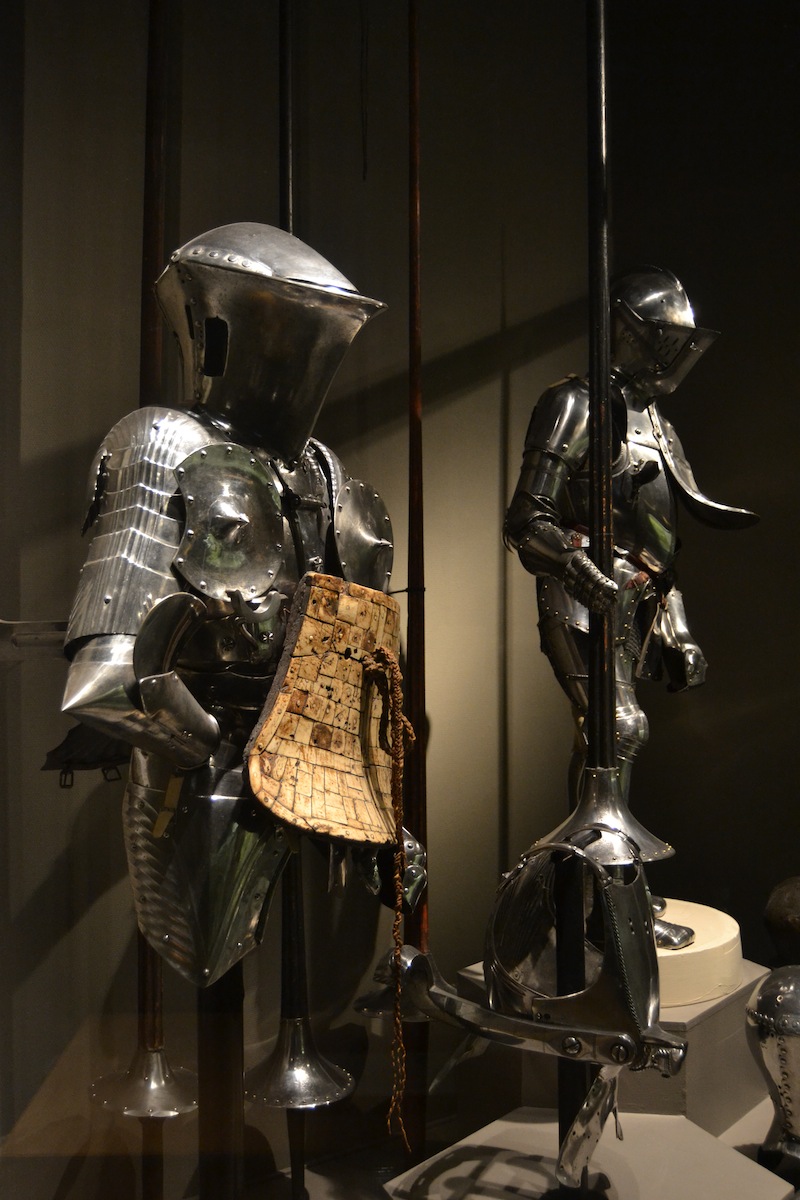
Europe is filled with many fine museums showcasing medieval arms and armor. Famous collections such as the Tower of London or the Hofburg in Vienna get top billing, but there are dozens more. One interesting collection can be found at The Royal Museum of the Armed Forces and of Military History in Brussels, Belgium.
The medieval section is well laid out with displays running chronologically. Armor and weapons from the same half-century are displayed together, giving the visitor a good overall idea of the military technology of that time.
Michaele Jordan Reviews Pantheon
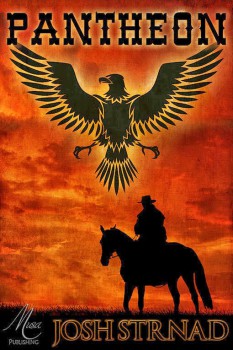 Pantheon
Pantheon
Josh Strnad
Urania Speculative Fiction, an imprint of Musa Publishing, Colorado Springs, CO (180 pp in Adobe pdf format, $4.99, Kindle edition, April 2014)
Reviewed by Michaele Jordan
Josh Strnad does not look like a horror writer. He’s not dark and brooding, or dressed in black leather. Rather, he’s young and blond, fresh faced and apple-cheeked. He looks like he just came straight from a Wisconsin dairy farm. (And for all I know, he did.) Yet he writes horror. It says so right there on his website.
You probably didn’t need me to tell you that. Quite likely you’ve caught one of his stories. He first came to my attention with ‘Hellevator,’ in Eric J. Guignard’s 2013 collection, After Death… An Anthology of Dark and Speculative Fiction Stories Examining What May Occur After We Die. But you may prefer ‘If You Should Die Before I Wake’ which appeared Nightmare Stalkers & Dream Walkers from Horrified Press, also in 2013.
He has not slacked off with the new year. His H.P. Lovecraft tribute, “Goddess of Our Fathers,” is featured in the new Dark Hall Press Cosmic Horror Anthology. And his latest story ‘The Last Kiss” (he tells us this is unlike anything else he’s ever written) will soon be available in Vignettes From The End Of The World.
In short, he’s written a lot of good stories. Which means it’s time for a novel. So. . . here it is! Pantheon is not, strictly speaking, horror, although it has its horrific moments. It’s more a cross-genre work, merging Greek mythology with the old West. Of course, Greek mythology may not count as a genre, but no matter. This isn’t the same Greek mythology you got from Edith Hamilton in school.
New Treasures: Voodoo Tales: The Ghost Stories of Henry S. Whitehead
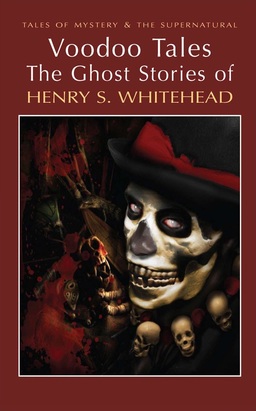 I continue to collect the Wordsworth Editions Tales of Mystery & The Supernatural, which I’ve found to be an inexpensive way to gather a diverse range of early horror writers on a single bookshelf.
I continue to collect the Wordsworth Editions Tales of Mystery & The Supernatural, which I’ve found to be an inexpensive way to gather a diverse range of early horror writers on a single bookshelf.
My latest acquisition was Voodoo Tales: The Ghost Stories of Henry S. Whitehead, which I bought because it was huge (691 pages!), inexpensive ($3.90!), and ’cause it had voodoo in it (voodoo!). What can I tell you, it was a compelling combo.
I’ve never heard of Henry S. Whitehead, but apparently he was an early Weird Tales writer who had two Arhkam House collections. You’d think I’d be more on top of an author who had a pair of Arhkam House collections, but no. This genre keeps finding more ways to surprise me.
I’m guessing that Whitehead wrote mostly voodoo tales, but I won’t know for sure until I dig into the volume. Until then, I’m relying on the cover and the text on the back, and I’m definitely picking up a voodoo vibe.
“And behind him, like a misshapen black frog, bounded the Thing, its red tongue lolling out of its gash of a mouth, its diminutive blubbery lips drawn back in a murderous snarl…”
Let Henry S. Whitehead take you into the mysterious and macabre world of voodoo where beasts invade the mind of man and where lives of the living are racked by the spirits of the dead. In this collection of rare and out of print stories you will encounter the curses of the great Guinea-Snake, the Sheen, the weredog whose very touch means certain death, the curious tale of the ‘magicked’ mirror, and fiendish manikins who make life a living hell. Included in this festival of shivering fear is the remarkable narrative ‘Williamson’ which every editor who read the story shied away from publishing.
With deceptive simplicity and chilling realism, Whitehead’s Voodoo Tales are amongst the most frightening ever written.
Jews With Swords: Gentlemen of the Road by Michael Chabon
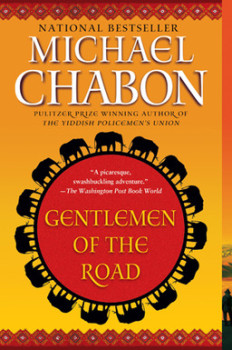 In 2002, Michael Chabon edited a collection of retro-pulp stories titled McSweeney’s Mammoth Treasury of Thrilling Tales, filled with stories by both literary writers and genre writers. I found it underwhelming. What grabbed me, though, was Chabon’s cri de couer for a return to plot in fiction. And in so doing he wanted writers to be able to use whatever genres they wanted to tell whatever stories they wanted, without fear of being dismissed as no longer writing “literature.”
In 2002, Michael Chabon edited a collection of retro-pulp stories titled McSweeney’s Mammoth Treasury of Thrilling Tales, filled with stories by both literary writers and genre writers. I found it underwhelming. What grabbed me, though, was Chabon’s cri de couer for a return to plot in fiction. And in so doing he wanted writers to be able to use whatever genres they wanted to tell whatever stories they wanted, without fear of being dismissed as no longer writing “literature.”
While he had by then written the superhero-themed novel Kavalier and Klay and the baseball and Norse Mythos mashup Summerland, he was known primarily as an author of literary fiction. From that point on, he threw himself deep into the waters of plot and genre. Since then, he’s written a Sherlock Holmes novella, The Final Solution, the Nebula- and Hugo-winning alternate history novel, The Yiddish Policeman’s Union, and the screenplay for John Carter.
In 2007, as part of his exploration of plot and genre, he wrote Gentlemen of the Road, an unabashed, fun-for-the-sake-of-fun swashbuckler. Hewing to its old roots, it was initially serialized in the New York Times Magazine. His working title and, as he writes, “in my heart the true” one, was Jews With Swords.
While he hoped to invoke memories of Jewish troopers at Antietam or Inkerman, or warriors like Bar Kochba and Judah Maccabee, most people found it too incongruous. But that incongruity, between Jews with swords and the modern steroptype of Jews as decidedly un-adventurous, was something Chabon wanted to explore. He notes that from their very begininning, when Abraham was told by God “lech lecha: Thou shalt leave home,” Jews have been wanderers and “by definition, find adventure.” In his own words, he “attempted to…find some shadowy kingdom where a self-respecting Jewish adventurer would not be caught dead without his sword or his battle-ax.”
Ancient Worlds: The Real Housewives of Mount Olympus
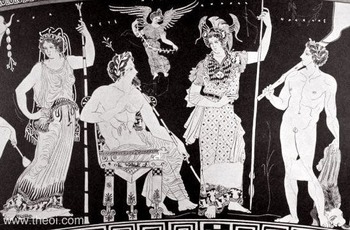 After the invocation of the Muse of Love that I discussed two weeks ago, the Argonautica launches into what is, quite honestly, one of my favorite scenes in all of ancient literature.
After the invocation of the Muse of Love that I discussed two weeks ago, the Argonautica launches into what is, quite honestly, one of my favorite scenes in all of ancient literature.
Apollonius gives us a conference among the gods to discuss our heroes’ fates. Homer has done the same on multiple occasions, but here, the conference is between two of Olympus’s leading goddesses, Hera and Athena.
Much as in the Odyssey, Athena is here fulfilling her role as the tutor of young heroes. She supports Jason in his quest much as she did (will) Odysseus. Hera also now stakes her interest in the outcome of the Argonaut’s quest: She really doesn’t like Pelias and wants to see him destroyed.
Together they decide that the best way for everyone to get what they want out of this is for Medea, the daughter of Aeetes, to fall in love with Jason. Not a little schoolgirl crush, either. No, this has to be a big whammy of a love, so much so that she is willing to betray her father and her people in order to assist Jason in his quest .
There’s just one problem: Athena’s a virgin and Hera is married. They know nothing about falling in love.
Little Blue Squares
 As a kid, Dungeons & Dragons introduced me to a lot of things, from fantasy books and authors I might otherwise not have encountered to obscure medieval weapons (like the voulge-guisarme) to equally obscure vocabulary (such as dweomer or weal). Reading my D&D books and modules was literally an educational experience and I am not ashamed to admit that many of my adult interests have their origins in things I first discovered through the game.
As a kid, Dungeons & Dragons introduced me to a lot of things, from fantasy books and authors I might otherwise not have encountered to obscure medieval weapons (like the voulge-guisarme) to equally obscure vocabulary (such as dweomer or weal). Reading my D&D books and modules was literally an educational experience and I am not ashamed to admit that many of my adult interests have their origins in things I first discovered through the game.
D&D also introduced me to the idea of using graph paper to make dungeon maps. Pictured to the left is the first dungeon map I ever saw (unless one counts the board to Dungeon!, which I don’t). The map appeared near the end of the blue rulebook included in my Basic Set and depicts one level beneath the ruined tower of the sorcerer Zenopus. As you can see, the map includes a square grid, with each square representing a 10 × 10 area, as was traditional in all the TSR Hobbies versions of the game. My Basic Set also included an adventure module, In Search of the Unknown, about which I talked before and its two-level dungeon exercised an equally strong influence over my young imagination.
I was, of course, familiar with graph paper, having used it in school during math classes, but I’d never seen it used for any other purpose. Consequently, I was a bit surprised to discover that D&D players bought it in large quantities, both referees in creating their own dungeons and players to keep track of their characters’ explorations of said labyrinths, lest they become lost and unable to find their way out again. I may have thought it odd at first, but I dutifully paid a visit to the local office supply store and bought myself a pad of paper so that I could get down to the business of laying out subterranean mazes of peril to inflict on my friends (or their characters at any rate).
Godzilla (2014) Is a True Godzilla Film and a Unique Blockbuster
 New to Godzilla? Read my 5-part history series.
New to Godzilla? Read my 5-part history series.
To all of those who saw the new Godzilla this last weekend who have never before fully understood the obsession fans have for this monster … now you will get it. Welcome to our weird world!
Godzilla isn’t just a massive monster that stomps stuff, confronts the military, and grapples with other monsters. Any giant beast can do that without much thought put into it. Godzilla is a character and a legacy. Even when playing the straight-up villain in films like 1964’s Mothra vs. Godzilla, the Big G is beyond larger than life and something you cannot help but gape at in awe and then salute. What a piece of work is a giant radioactive reptile! In apprehension how like a god(zilla)!
Director Gareth Edwards’s 2014 take on Godzilla, only the second film from a U.S. studio featuring the monster (or, if you ask most fans, the first), is a genuine Godzilla movie. Edwards’s creature isn’t the greatest incarnation to grace the silver screen, something I’m sure he would admit, as nothing could re-capture the cultural magic and hands-on effects work of director Ishiro Honda and special effects creator Eiji Tsubaraya from the classic series. But the Edwards Godzilla is a legitimate and superb version that achieves the gravity of the 1954 orignal Godzilla and the thrilling monster-vs.-monster mayhem of the films that followed it through three eras and six decades. For Godzilla fans, this movie contains the sheer ecstasy of a dream realized that brings spontaneous cheers, gasps of admiration, and watery-eyed moments of recognition. I could not imagine a better way to craft a U.S.-made Godzilla film, and it is to the immense credit of Edwards and everyone involved that, until now, I could not have foreseen how such a feat was even possible.
Even for those with scant knowledge of the great monster except what comes from the pop culture mill, Godzilla ‘14 is as an unusual Hollywood blockbuster. Gareth Edwards and Co. crafted a movie that stands apart from the stateside summer thrill machines as much as the Japanese films of 1960s did from their U.S. counterparts. Godzilla plays at the slow build, purposely restraining the sprawling spectacle until unleashing the finale. During the first two thirds, the suspense centers around scenes where the monsters remain glimpsed, their masses emphasized to drive the action without making them the centerpieces. Godzilla doesn’t receive a full reveal until an hour in, and the movie immediately leaps away after the unveiling. Instead of signaling the opening of the mayhem, the moment switches into the next step of the gradual climb to the plateau. Where many blockbusters pummel audiences with as much noise and pixels as they can afford until viewers feel only numbness for the finale, Godzilla wants to make them breathless in anticipation for the climax so that when it arrives, it means something.
One of the Best Serials Ever Made: The Adventures of Captain Marvel, Chapter One: Curse of the Scorpion
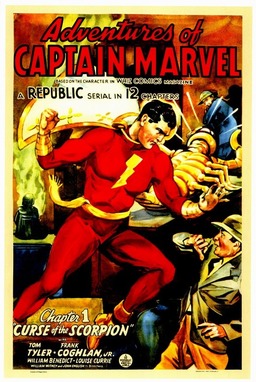 Pop quiz. Who was the first superhero to make it into film?
Pop quiz. Who was the first superhero to make it into film?
Yes — you in the back…what? Spawn?! Sit down! Okay… you there, in the Marvel Zombie tee-shirt… no, it was not Wolverine, though there may never be another superhero movie made without him. Yes, I see you… Superman? Good guess, but nope. Batman? Warmer, but still no.
The first superhero to make it into the movies was Captain Marvel (or as his four-color arch-nemesis, Dr. Thaddeus Bodog Sivana, contemptuously dubbed him, “That Big Red Cheese”), in the 1941 serial, The Adventures of Captain Marvel.
Captain Marvel and his alter ego, young radio reporter Billy Batson, made their first appearance in Fawcett’s Whiz Comics #2, in February of 1940. The character, the creation of writer Bill Parker and artist C.C. Beck, quickly became extremely popular, and for the remainder of the 1940’s, comics featuring him and the other members of the “Marvel Family” often outsold those featuring Superman.
National Periodical Publications (commonly known to comics fans as DC) tried to nip the rivalry in the bud by suing Captain Marvel out of existence in a legal wrangle that wouldn’t be decisively resolved until 1954. Well before that, though, Republic Pictures hopped on the bandwagon with The Adventures of Captain Marvel, a twelve-chapter serial that aficionados of the form regard as one of the best ever made.
The serial was directed by John English and William Whitney and written by the team of Ronald Davidson, Norman Hall, Arch Heath, Joseph Poland, and Sol Shor. They all keep the pot bubbling with action, peril, suspense, red herrings, and the crackling, popping energy that seems to be a unique feature of the best cliffhanger serials.
D&D Announces A Tyranny of Dragons
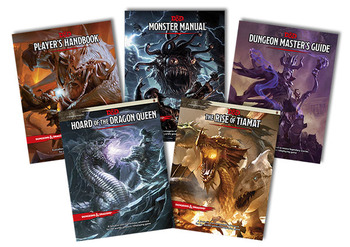 Setting the stage for the release of the newest set of Dungeons & Dragons rules, Wizards of the Coast today announced that August 2014 would mark the start of their Tyranny of Dragons campaign. In addition to the core manuals for the Dungeons & Dragons game system, the campaign will feature adventures within the Dungeons & Dragons setting, both in printed books for tabletop play and also as a new game module released for their Neverwinter game. The adventure begins on August 14 and winds its way through a number of key releases that are looking to modernize the game.
Setting the stage for the release of the newest set of Dungeons & Dragons rules, Wizards of the Coast today announced that August 2014 would mark the start of their Tyranny of Dragons campaign. In addition to the core manuals for the Dungeons & Dragons game system, the campaign will feature adventures within the Dungeons & Dragons setting, both in printed books for tabletop play and also as a new game module released for their Neverwinter game. The adventure begins on August 14 and winds its way through a number of key releases that are looking to modernize the game.
The D&D Player’s Handbook is slated for release on August 19, 2014. The revised D&D Monster Manual will be available in September. The D&D Dungeon Master’s Guide releases on November 18, 2014. All three books will have a retail price of $49.95 ($57 Canadian).
Tabletop fans will be able to join in on the Tyranny of Dragons adventuring action (also released on Aug. 19) with the adventure supplement Hoard of the Dragon Queen, for $29.95 ($35 Canadian):
In an audacious bid for power the Cult of the Dragon, along with its dragon allies and the Red Wizards of Thay, seek to bring Tiamat from her prison in the Nine Hells to Faerun. To this end, they are sweeping from town to town, laying waste to all those who oppose them and gathering a hoard of riches for their dread queen. The threat of annihilation has become so dire that groups as disparate as the Harpers and Zhentarim are banding together in the fight against the cult. Never before has the need for heroes been so desperate.
